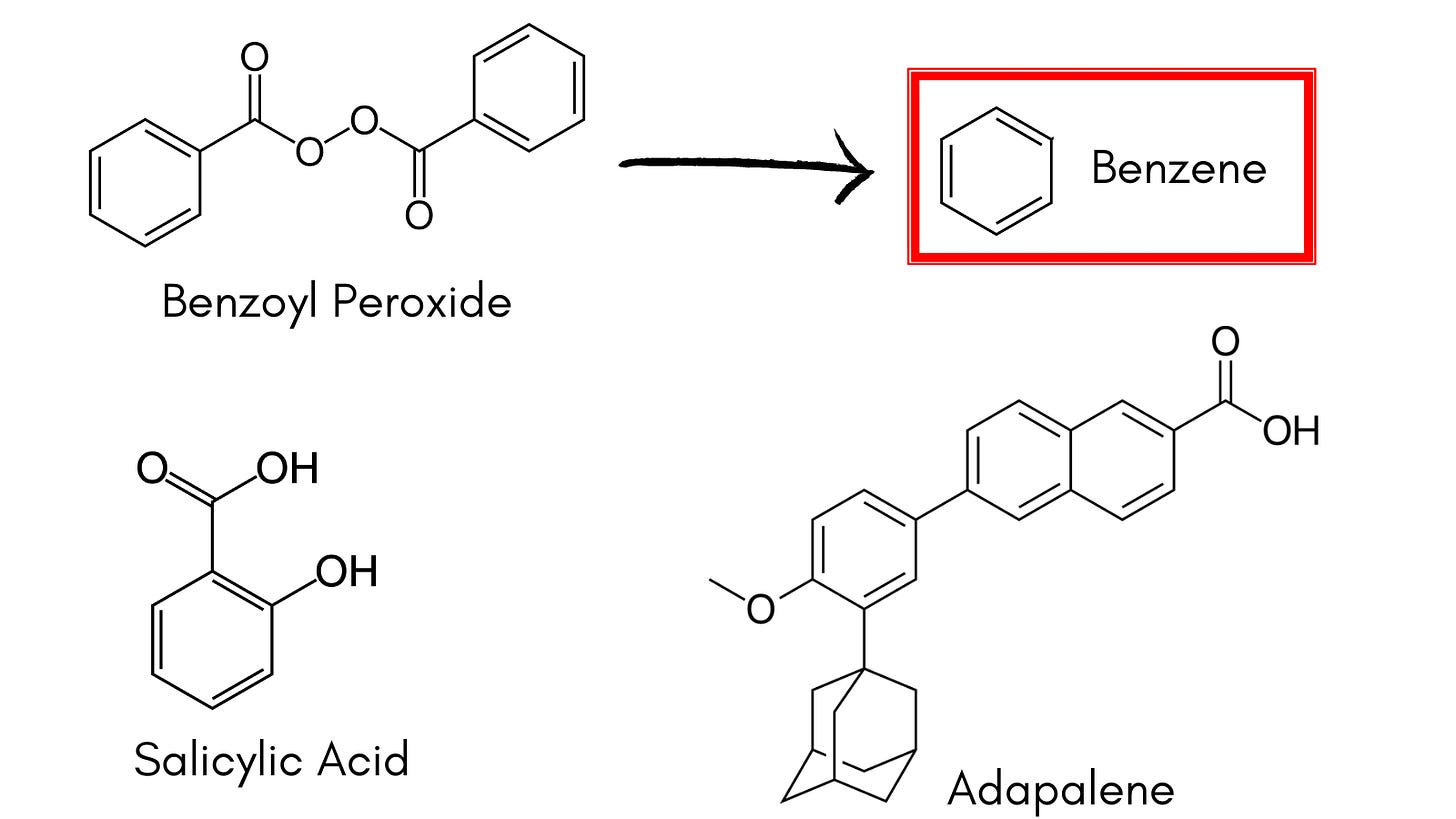Acne Medication in the News
There are two popular ingredients used in over the counter acne products: one a synthetic chemical, and the other natural. The synthetic ingredient is linked to cancer.

Yesterday, an alarming report was released concerning the presence of a carcinogenic (cancer causing) chemical found in many popular over-the-counter (OTC) topical medications for the treatment of acne. In today’s post, I break down the science behind this alarming report and share what I’ve done in response in my own household.
There are a number of different topical and oral medications used to manage the inflammatory skin disease of acne. Among OTC topicals, two of the most popular agents incorporated into soaps and creams are salicylic acid (from the willow tree) or the synthetic molecule, benzoyl peroxide (BPO), which was first synthesized by a German scientist in 1858.
In addition to its applications in topical skin remedies for acne, BPO has a number of other industrial applications including in the production of plastics and as a bleaching agent.
When it comes to acne treatment, BPO is used alone or in combination with other acne therapies such as salicylic acid, retinoids, or certain antibiotics. It is an an important ingredient in the dermatological toolkit for the management of acne.

Why the reason for alarm over BPO?
Yesterday, the news broke in that high levels of benzene—a molecule that causes cancer—was found in numerous BPO acne products. Sample headlines:
Reuters. “Cancer-causing chemical found in Clinique, Clearasil acne treatments, U.S. lab reports”
Bloomberg. “Chemical Linked to Cancer Found in Acne Creams Including Proactiv, Clearasil”
The report came from the independent testing lab, Valisure LLC, which filed a petition with the FDA to investigate and to recall these treatments until an investigation has been conducted. Importantly, the FDA has not yet investigated or rendered a decision.
What were the major findings in the report?
Valisure tested 66 BPO-containing products, including various formulations such as washes, gels, creams, and lotions. Benzene is a very unsafe molecule and the current FDA guidelines only allow for up to 2 parts per million (ppm) of benzene in products. Instead, Valisure found products with 12 times more than the allowable limit. For products subjected to heat (such as the temperature of a medicine left in a hot car), they found products containing from 114 to 1761 ppm—that is 57X to 880X the allowable limit!

While most of us would not store our medicine under conditions of long-term heat exposure, we also don’t have control over how products may be handled before they reach store shelves. The benzene here is not an additional contaminant introduced to the medicine, but rather a byproduct of the breakdown of the BPO ingredient. Thus, this affects all products containing BPO.
What to do?
While I am not a physician and cannot give medical advice, I am a mother of teens with acne and can share what I have done in response to these findings. For now, I’ve removed all BPO containing products from our medicine cabinet. Remember, some products don’t just contain BPO, but may also be formulated in combination with other acne drugs. Here is a list of some of the affected products, but is not comprehensive. Read your labels carefully if you wish to remove BPO from your medicine cabinet:
Proactiv 2.5% BPO cream
Up & Up 2.5% BPO Cream
Walgreens 10% BPO bar
Harris 10% BPO wash
Clinique 2.5% BPO cream
Clearasil 10% BPO cream
La Roche-Posay 5.5% BPO cream
PanOxyl 10% BPO cream
Sandra Lee MD 2.5% BPO lotion
Oxy 10% BPO cream
Galderma 5% BPO cream
Equate 10% BPO cream
Differin 5% BPO cream
CeraVe 4% BPO cream
Sandoz 5% BPO gel
TARO 2.5% BPO gel
Neutrogena 10% BPO gel
The Takeaway
While BPO has been an important medicine in the fight against acne, we luckily have other safe options to explore for management of this inflammatory skin condition. Talk to your pediatrician, primary care doctor, or dermatologist to determine the best treatment regimen for you or your child.
Yours in health, Dr. Quave
Cassandra L. Quave, Ph.D. is a scientist, author, speaker, podcast host, wife, mother, explorer, and professor at Emory University School of Medicine. She teaches college courses and leads a group of research scientists studying medicinal plants to find new life-saving drugs from nature. She hosts the Foodie Pharmacology podcast and writes the Nature’s Pharmacy newsletter to share the science behind natural medicines. To support her effort, consider a paid or founding subscription, with founding members receiving an autographed 1st edition hardcover copy of her book, The Plant Hunter.
Available in hardcover, paperback, audio, and e-book formats!






Yikes, and thanks for highlighting this. In terms of efficacy and side effects, a combination of adapalene (name brand Differin) and benzoyl peroxide is considered a good first line treatment combination for mild/moderate acne in primary care guidelines.
The combination is called Epiduo.
From what you're reporting, it seems like temperature control is a very overlooked imperative to help prevent BPO--> benzene break down.
Will read more about this and check back in if there are statements from the medical journals/authorities I follow. For now I'm thinking I'll continue with the salicylic acid and cleansing regimen my wife coordinates with our daughter... and skip the benzoyl peroxide.
Adapalene can cause a temporary worsening of acne and skin irritation, so it's hard to get sustained compliance for many.